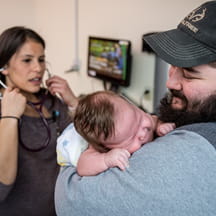The High Acuity Readmission Risk Pediatric Screen (HARRPS) Tool© is well-established in reducing children’s hospital inpatient readmissions. For its creators, getting to that point has been an unexpected journey.
“Like many quality improvement initiatives, we initially thought we’d have it up and running in a few weeks,” said Blair Buenning, MSN, RN, CPN, ACM-RN, quality improvement consultant at Children’s Mercy Kansas City. “We realized very quickly it was going to be a long process.”
It began in 2017 around Children’s Mercy’s nursing care management initiatives. While screening patients to determine their case management needs, Buenning and her team discovered there was no tool readily available to assess pediatric readmission risks. The need was clear: Centers for Medicare and Medicaid Services and the Pediatric Quality Measures Program consider readmissions as a quality indicator for hospitals. Additionally, preventable pediatric readmissions in the U.S. cost $1.5 billion annually.
Reviewing the available literature, the Children’s Mercy team launched the HARRPS tool in 2018 with eight primary factors to determine readmission risk. They conducted research to assign weighted values to each risk category; the sum of those values would predict whether the patient was at a low, medium, or high risk for readmission.
The original HARRPS tool screened patients for:
- Admitting diagnosis. Those included anemia, appendectomy, gastroenteritis, and seizure, as well as upper respiratory issues, such as asthma, bronchiolitis, and pneumonia.
- Chronic conditions. Patients with two or more chronic conditions are at higher risk for readmission.
- History. Readmissions within the last 30 days or six months are weighted more heavily in the tool.
- Acuity. This considers if the patient was initially admitted into a higher-acuity unit, such as the PICU, NICU, or CICU.
- Insurance. Patient families using Medicaid or self-pay are statistically at higher risk for readmission.
- In-home care. Patients using in-home therapy, durable medical equipment, or nursing services are more likely to be readmitted—and comprise three separate risk factors weighted in the HARRPS tool.
The team’s initial research included the patient family’s primary language as a factor, but the data revealed a minimal impact. “That surprised us,” Buenning said. “But even though that isn't in the scorecard, it is still something we consider for teaching and discharge instructions.”
Follow-up research supports effectiveness
The group’s study showed the HARRPS tool to be effective. Its 0.68 c-statistic score — the probability it can accurately assess a patient’s readmission risk level — indicated a solid statistical model.
In 2023, the Children’s Mercy team published a validation study that further proved HARRPS’ accuracy, this time with a 0.80 c-statistic score. The recent research also led to two substantial changes to the screening tool: reducing risk classifications to two and eliminating admission diagnosis from the screener.
“There are often a lot of factors you may not know in those first 24 hours,” Buenning said. “Removing the admission diagnosis really streamlines the process for frontline users and further sustains the tool’s validity and reliability.”
Allow time for change
The primary focus for Buenning and her team now is sharing HARRPS with other health care institutions. She said dozens of children’s hospitals are in various stages of implementation, and she fields a few calls each week with additional inquiries. While some are adapting the tool in its original form — pen and paper — Children’s Mercy advises others on integrating the screener directly within the EMR.
No matter the approach, it’s important to be patient when introducing HARRPS. “A lot of it comes down to basic change management,” Buenning said. “Explain its purpose to garner buy-in, and just be realistic about how things move sometimes, knowing there's a light at the end of the tunnel.”


